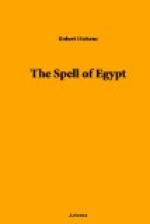And yet in Medinet-Abu there reigns a splendid calm—a calm that sometimes seems massive, resistant, as the columns and the walls. Peace is certainly inclosed by the stones that call up thoughts of war, as if, perhaps, their purpose had been achieved many centuries ago, and they were quit of enemies for ever. Rameses III. is connected with Medinet-Abu. He was one of the greatest of the Egyptian kings, and has been called the “last of the great sovereigns of Egypt.” He ruled for thirty-one years, and when, after a first visit to Medinet-Abu, I looked into his records, I was interested to find that his conquests and his wars had “a character essentially defensive.” This defensive spirit is incarnated in the stones of these ruins. One reads in them something of the soul of this king who lived twelve hundred years before Christ, and who desired, “in remembrance of his Syrian victories,” to give to his memorial temple an outward military aspect. I noticed a military aspect at once inside this temple; but if you circle the buildings outside it is more unmistakable. For the east front has a battlemented wall, and the battlements are shield-shaped. This fortress, or migdol, a name which the ancient Egyptians borrowed from the nomadic tribes of Syria, is called the “Pavilion of Rameses III.,” and his principal battles are represented upon its walls. The monarch does not hesitate to speak of himself in terms of praise, suggesting that he was like the God Mentu, who was the Egyptian war god, and whose cult at Thebes was at one period more important even than was the cult of Amun, and also plainly hinting that he was a brave fellow. “I, Rameses the King,” he murmurs, “behaved as a hero who knows his worth.” If hieroglyphs are to be trusted, various Egyptian kings of ancient times seem to have had some vague suspicion of their own value, and the walls of Medinet-Abu are, to speak sincerely, one mighty boast. In his later years the king lived in peace and luxury, surrounded by a vicious and intriguing Court, haunted by magicians, hags, and mystery-mongers. Dealers in magic may still be found on the other side of the river, in happy Luxor. I made the acquaintance of two when I was there, one of whom offered for a couple of pounds to provide me with a preservative against all such dangers as beset the traveller in wild places. In order to prove its efficacy he asked me to come to his house by night, bringing a dog and my revolver with me. He would hang the charm about the dog’s neck, and I was then to put six shots into the animal’s body. He positively assured me that the dog would be uninjured. I half-promised to come and, when night began to fall, looked vaguely about for a dog. At last I found one, but it howled so dismally when I asked Ibrahim Ayyad to take possession of it for experimental purposes, that I weakly gave up the project, and left the magician clamoring for his hundred and ninety-five piastres.
Its warlike aspect gives a special personality to Medinet-Abu. The shield-shaped battlements; the courtyards, with their brutal columns, narrowing as they recede towards the mountains; the heavy gateways, with superimposed chambers; the towers; quadrangular bastion to protect, inclined basement to resist the attacks of sappers and cause projectiles to rebound—all these things contribute to this very definite effect.




